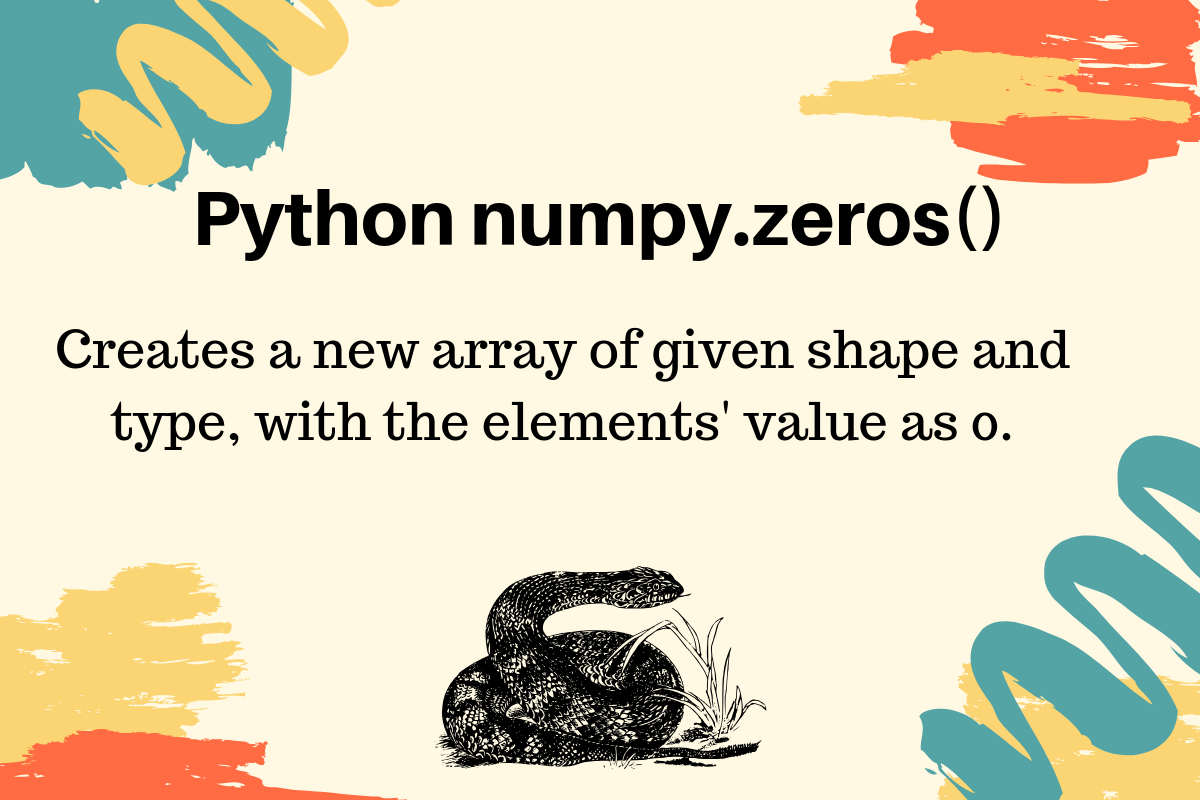- Log in to:
- Community
- DigitalOcean
- Sign up for:
- Community
- DigitalOcean

Python numpy.zeros() function returns a new array of given shape and type, where the element’s value as 0.
numpy.zeros() function arguments
The numpy.zeros() function syntax is:
zeros(shape, dtype=None, order='C')
- The shape is an int or tuple of ints to define the size of the array.
- The dtype is an optional parameter with default value as float. It’s used to specify the data type of the array, for example, int.
- The order defines the whether to store multi-dimensional array in row-major (C-style) or column-major (Fortran-style) order in memory.
Python numpy.zeros() Examples
Let’s look at some examples of creating arrays using the numpy zeros() function.
1. Creating one-dimensional array with zeros
import numpy as np
array_1d = np.zeros(3)
print(array_1d)
Output:
[0. 0. 0.]
Notice that the elements are having the default data type as the float. That’s why the zeros are 0.
2. Creating Multi-dimensional array
import numpy as np
array_2d = np.zeros((2, 3))
print(array_2d)
Output:
[[0. 0. 0.]
[0. 0. 0.]]
3. NumPy zeros array with int data type
import numpy as np
array_2d_int = np.zeros((2, 3), dtype=int)
print(array_2d_int)
Output:
[[0 0 0]
[0 0 0]]
4. NumPy Array with Tuple Data Type and Zeroes
We can specify the array elements as a tuple and specify their data types too.
import numpy as np
array_mix_type = np.zeros((2, 2), dtype=[('x', 'int'), ('y', 'float')])
print(array_mix_type)
print(array_mix_type.dtype)
Output:
[[(0, 0.) (0, 0.)]
[(0, 0.) (0, 0.)]]
[('x', '<i8'), ('y', '<f8')]

Reference: API Doc
Thanks for learning with the DigitalOcean Community. Check out our offerings for compute, storage, networking, and managed databases.
About the author
Java and Python Developer for 20+ years, Open Source Enthusiast, Founder of https://www.askpython.com/, https://www.linuxfordevices.com/, and JournalDev.com (acquired by DigitalOcean). Passionate about writing technical articles and sharing knowledge with others. Love Java, Python, Unix and related technologies. Follow my X @PankajWebDev
Still looking for an answer?
- Table of contents
- numpy.zeros() function arguments
- Python numpy.zeros() Examples
Deploy on DigitalOcean
Click below to sign up for DigitalOcean's virtual machines, Databases, and AIML products.
Become a contributor for community
Get paid to write technical tutorials and select a tech-focused charity to receive a matching donation.
DigitalOcean Documentation
Full documentation for every DigitalOcean product.
Resources for startups and SMBs
The Wave has everything you need to know about building a business, from raising funding to marketing your product.
Get our newsletter
Stay up to date by signing up for DigitalOcean’s Infrastructure as a Newsletter.
New accounts only. By submitting your email you agree to our Privacy Policy
The developer cloud
Scale up as you grow — whether you're running one virtual machine or ten thousand.
Get started for free
Sign up and get $200 in credit for your first 60 days with DigitalOcean.*
*This promotional offer applies to new accounts only.
